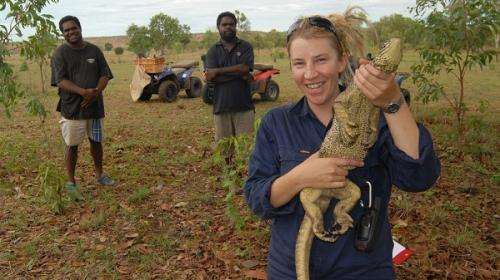Kimberley goannas trained in cane toad taste-aversion

A PhD candidate and Indigenous rangers are working to train wild goannas to avoid eating toxic cane toads (Bufo marinus).
Herpetologist Georgia Ward-Fear says the method involves feeding juvenile toads to goannas in the wild.
The small toads are toxic enough to make the goannas sick, but not enough to kill them, hopefully instilling an aversion.
"With conditioned taste-aversion, it's like if you develop an aversion to something like a toxic or a spoiled substance based off a negative experience that you have with it," she says.
Ms Ward-Fear says the fieldwork started in July 2013, when she and Balingarra rangers began a survey of yellow-spotted monitors (Varanus panopte) and sand goannas (Varanus gouldii) at the abandoned Aboriginal community of Oombugurri, East Kimberley.
They chose the site because it was relatively accessible, likely to be soon invaded by cane toads and, according to the rangers, had plenty of goannas.
Ms Ward-Fear says the rangers' tracking skills proved invaluable in finding so many of the animals.
During the survey they fitted a number of goannas with radio tracking collars.
With transmitters in place she was then able to track each lizard to its burrow and place a Perspex "arena" around it, containing a juvenile toad.
Many of the goannas emerged and ate the toad.
While the research is still in this "training" phase, Ms Ward-Fear says they usually seem to survive their cane toad meal.
However a surprising number of large goannas end up in the stomachs of even larger black-headed pythons (Aspidites melanocephalus) and olive pythons (Liasis olivaceus), where transmitters continue to transmit radio signals from within.
While it is yet to be confirmed, she suspects the goannas that refuse to eat the small toads are all females—a disturbing trend if invading cane toads tend to wipe out all breeding males in a population.
Meanwhile feral cane toads have started to arrive at Oombulgurri, so the effectiveness of this taste-and-scent aversion method can be tested.
Ms Ward-Fear says her study follows an earlier taste-and-scent aversion project in the upper Ord Valley, where her colleague Stephanie O'Donnell encouraged wildlife to eat special cane toad sausages.
While quolls readily took the baits they had difficulty getting goannas to eat them.
She says while it is impossible to achieve 100 per cent survival for these vulnerable species when the toads arrive, they aim to help enough breeding toads to survive for a viable population to continue.
Provided by Science Network WA

















